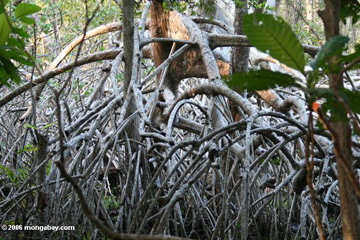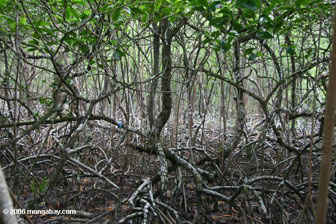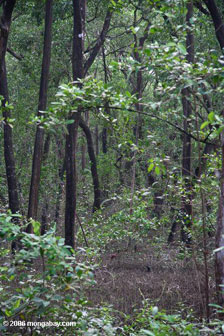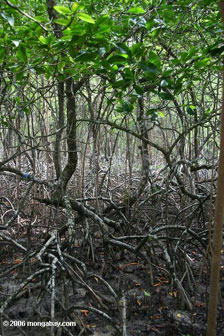What if, instead of a nasty oil disaster in the Gulf of Mexico, the U.S. public was now confronted with a natural catastrophe in the Grand Canyon or in California Redwood forests? Within the popular imagination, certain types of ecosystems elicit more sympathy than others, and very low on the totem pole are mangrove forests. Located in the tropics, mangroves are a mess of thick, tangled salt-tolerant trees and shrubs which thrive in brackish tidal waters. When I paddled through the Florida Everglades in a canoe some fifteen years ago, I found mangroves bizarre looking: trees have long roots which stick out above the water level.
Perhaps because they are swampy and inhospitable, mangroves have failed to capture the public’s attention. Yet, they fulfill a vital environmental purpose as they are home to a wide diversity of plant and animal life. What’s more, their myriad exposed roots provide a nursery for many commercial and recreational fish species, including shrimp and spiny lobster. Above water, they serve as a nesting and foraging area for wading and fish-eating birds.
 Mangrove forest. Photo by R. Butler. |
While whales and dolphins are adored by the public and receive attention from environmentalists, few are aware of other aquatic mammals such as manatees and dugongs which rely on mangrove habitat [to read my article about the plight of one manatee now on its way from Florida to Alabama, click here].
What will it take for the public to become more aware of these vital swampy ecosystems? Tragically, some may only learn of their existence as a result of the ecological crisis afflicting the Gulf of Mexico. There, the BP spill poses a direct threat to 800 square miles of U.S. mangrove habitat located in Louisiana, Texas and the southern tip of Florida. Since 1980, upstream development and damming have felled 30% of Gulf Coast mangroves, and the oil disaster could well finish the job.
Antecedents in Venezuela
It’s not the first time oil has posed a threat to mangrove ecosystems. I first became aware of this insidious connection while carrying out research on my dissertation which dealt with the environmental history of oil in Venezuela. In the early twentieth century, subsidiaries of Standard Oil and Royal Dutch Shell moved into the Lake Maracaibo area, located in the westernmost section of the country, with dire consequences for the environment.
Prior to the oil boom in the 1920s, wildlife on the east bank of Lake Maracaibo thrived within jungle and marshes. On the coastline grew mangroves which supported distinct microhabitats of birds, mammals, reptiles, gastropods, crustaceans, insects and fish. One naturalist reported that jaguars prowled local mangroves and “in some of the mangrove swamps near Maracaibo their trails are frequently found.” Manatees, sawfish and caymans meanwhile plied the lake’s mangrove waters.
Though mangrove contamination must have surely occurred, it’s difficult to calculate the exact damage as we don’t know the precise location of all these ecosystems during the first years of the oil boom. The death of local mangroves could have led to the destruction of habitat for many other organisms such as oysters and crabs, which typically live on and among aerial roots or in sediments. These would have been killed directly by smothering and/or toxic effects.
 Mangrove forest. Photo by R. Butler. |
In general, oil enters mangrove forests at high tide and is deposited on aerial roots and sediment surface when the tide goes down. Mangroves can be killed by heavy or viscous oil which covers breathing pores on aerial roots, thus depriving the subsurface roots of oxygen. Mangroves can also be killed if oil penetrates sediments, through toxic effects of oil on subsurface roots. Root cell membranes are damaged, which impairs their normal salt exclusion function. The resulting influx of salt is a source of stress to the plants.
Some local mangroves were located right in the crosshairs of local oil development. Take, for example, the great swamp of Lagunillas which occupied 10 square miles and was covered in mangroves and other aquatic vegetation. One ornithologist remarked that “on the large cienaga at Lagunillas there were thousands of tree ducks…While not allowing a close approach when resting on the water, these ducks when flying seemed to have little fear of a boat.” Unfortunately, oil fouled local waters and in 1928 petroleum actually ignited on the lake itself, leading to a large conflagration [to read my full article on offshore oil operations in Venezuela and the Lagunillas fire, click here].
From the Gulf War to the Gulf of Mexico
Having trammeled the environment in Venezuela, the oil industry moved on to the Middle East where it encountered more mangroves and an aquatic mammal called the sea cow or dugong, cousin of the Lake Maracaibo manatee. Off the coast of Bahrain, large seagrass pastures supported 2,000-3,500 dugongs, creatures which inspired mariners of old to envision mermaids.
Carrying out oil exploration in such close proximity to mangroves in the Persian Gulf was bad enough, but in 1991 the situation became even worse with the onset of war between Iraq and the U.S. At one point, the Persian Gulf became the site of massive oil spills, some of them the result of bombing and artillery barrages which targeted storage tanks and refineries.
Yet Iraq, which intentionally dumped oil from several tankers into the Persian Gulf in an effort to ward off a potential landing of U.S. marines, may have been the greatest environmental culprit. During the Gulf War, no fewer than 1 million barrels of oil contaminated local waters, with some estimates ranging up to a whopping 6 million barrels. Major mangrove forests were seriously damaged, hundreds of dolphins and porpoises died, and, catastrophically, between 20-30,000 seabirds perished including flamingoes, herons and cormorants.
Environmentalists grew particularly concerned with the fate of Bahrain’s Tubli Bay, a complex system of flats and mangroves. Home to dugongs, sea turtles and shrimp, Tubli lay in the path of one damaging spill which had spread all the way from Iraqi-occupied Kuwait. As the spill hit, it killed off plankton and algae which fed local fish.
A Collective Moral Failure

Mangrove forest. Photos by Rhett A. Butler |
While oil spills are devastating for the environment in general, they are particularly damaging for mangroves. That’s because oil persists far longer within such ecosystems. One mangrove expert has remarked, “Never, ever let oil get into a mangrove coast. You’ll never get it out. It’s like a sponge you rub on a greasy bacon pan. You need very hot water and a lot of soap, and you still might just give up and throw away the sponge.”
Once contamination takes place, the possibility of recovering the environment may be limited: if mangrove prop roots become oiled the entire mangrove tree may die. What’s more, because mangrove trees grow so slowly, replacing them can take decades. In the Gulf of Mexico, forests are tightly bunched and as a result people won’t be able to get into swamps to wipe them down. In addition, there are literally hundreds of millions of trees.
Perhaps the only way to save some forests may be to laboriously scrape away a thin surface layer of soil to allow plants to grow. Scientists stress, however, that it’s important not to push petroleum under the surface or remove rootstalks lying just beneath the surface. In addition, if there’s a lot of oil this will complicate any rescue effort as rising and falling tides will simply add new coatings of crude.
While all logistical and technological means should be deployed to save Gulf mangroves, realistically we could be looking at significant damage all across the region. At this point, our best hope may be to minimize the environmental loss that’s already occurred and hopefully head off a full scale disaster in the Florida Everglades.
Sadly, it may take a further tragedy for people to wake up to what we have lost. Experts agree that one of the most vital services performed by mangroves is to protect human settlements from storm surges and wind storms. It’s a particularly crucial asset to consider in the hurricane-battered Gulf region. If Gulf mangroves are destroyed, a vital buffer will be eliminated. Additionally, the current BP oil spill could give rise to a vast surplus of potentially lethal hardwood.
Why has it been so difficult to acknowledge the important environmental services provided by mangroves? Harsh and forbidding, these habitats don’t capture the popular imagination to the same degree as other national treasures. Slow moving manatees and sea cows aren’t nearly as well known as dolphins. If this disaster reveals anything, however, it is the fundamental fallacy of this mindset and the need to preserve all ecosystems and creatures equally.
Nikolas Kozloff is the author of No Rain in the Amazon: How South America’s Climate Change Affects the Entire Planet (Palgrave, 2010). Visit his website, nikolaskozloff.com














